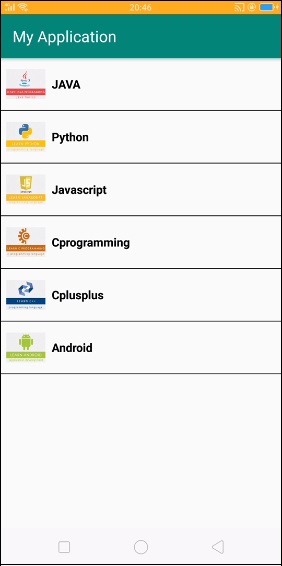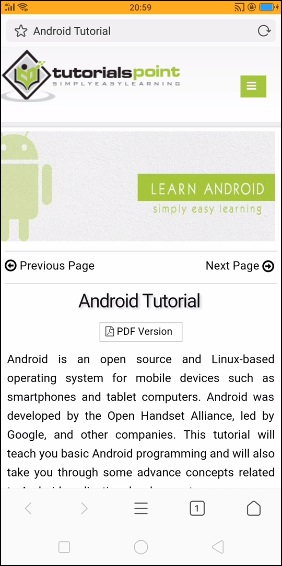
 Data Structure
Data Structure Networking
Networking RDBMS
RDBMS Operating System
Operating System Java
Java MS Excel
MS Excel iOS
iOS HTML
HTML CSS
CSS Android
Android Python
Python C Programming
C Programming C++
C++ C#
C# MongoDB
MongoDB MySQL
MySQL Javascript
Javascript PHP
PHP
- Selected Reading
- UPSC IAS Exams Notes
- Developer's Best Practices
- Questions and Answers
- Effective Resume Writing
- HR Interview Questions
- Computer Glossary
- Who is Who
How to display a list of images and text in a ListView in Android?
Before getting into listview example, we should know about listview, Listview is a collection of items pulled from arraylist, list or any databases. Most uses of listview is a collection of items in vertical format, we can scroll up/down and click on any item.
What is custom listview?
Custom listview works based on customAdapter. In this custom adapter we can pass custom object. We are passing subject data to listview as shown below.
Step 1 − Create a new project in Android Studio, go to File ⇒ New Project and fill all required details to create a new project.
Step 2 − Add the following code to res/layout/activity_main.xml.
<?xml version = "1.0" encoding = "utf-8"?> <android.support.constraint.ConstraintLayout xmlns:android = "http://schemas.android.com/apk/res/android" xmlns:tools = "http://schemas.android.com/tools" android:layout_width = "match_parent" android:layout_height = "match_parent"> <LinearLayout android:layout_width = "match_parent" android:layout_height = "match_parent" android:orientation = "vertical"> <ListView android:id = "@+id/list" android:layout_width = "wrap_content" android:layout_height = "match_parent" android:divider = "#000" android:dividerHeight = "1dp" android:footerDividersEnabled = "false" android:headerDividersEnabled = "false"/> </LinearLayout> </android.support.constraint.ConstraintLayout>
In the above activity_main.xml, we have declared a listview and added divider as shown below.
<ListView android:id = "@+id/list" android:layout_width = "wrap_content" android:layout_height = "match_parent" android:divider = "#000" android:dividerHeight = "1dp" android:footerDividersEnabled = "false" android:headerDividersEnabled = "false" />
Step 3 − Add the following code to src/MainActivity.java
import android.os.Bundle;
import android.support.v7.app.AppCompatActivity;
import android.widget.ListView;
import java.util.ArrayList;
public class MainActivity extends AppCompatActivity {
@Override
protected void onCreate(Bundle savedInstanceState) {
super.onCreate(savedInstanceState);
setContentView(R.layout.activity_main);
final ListView list = findViewById(R.id.list);
ArrayList<SubjectData> arrayList = new ArrayList<SubjectData>();
arrayList.add(new SubjectData("JAVA", "https://www.tutorialspoint.com/java/", "https://www.tutorialspoint.com/java/images/java-mini-logo.jpg"));
arrayList.add(new SubjectData("Python", "https://www.tutorialspoint.com/python/", "https://www.tutorialspoint.com/python/images/python-mini.jpg"));
arrayList.add(new SubjectData("Javascript", "https://www.tutorialspoint.com/javascript/", "https://www.tutorialspoint.com/javascript/images/javascript-mini-logo.jpg"));
arrayList.add(new SubjectData("Cprogramming", "https://www.tutorialspoint.com/cprogramming/", "https://www.tutorialspoint.com/cprogramming/images/c-mini-logo.jpg"));
arrayList.add(new SubjectData("Cplusplus", "https://www.tutorialspoint.com/cplusplus/", "https://www.tutorialspoint.com/cplusplus/images/cpp-mini-logo.jpg"));
arrayList.add(new SubjectData("Android", "https://www.tutorialspoint.com/android/", "https://www.tutorialspoint.com/android/images/android-mini-logo.jpg"));
CustomAdapter customAdapter = new CustomAdapter(this, arrayList);
list.setAdapter(customAdapter);
}
}
In the mainActivity, we have declared CustomAdapter and passed SubjectData as shown below.
CustomAdapter customAdapter = new CustomAdapter(this, arrayList); list.setAdapter(customAdapter);
Step 4 − Create a CustomAdapter class Add the following code to src/ CustomAdapter.java
import android.content.Context;
import android.database.DataSetObserver;
import android.view.LayoutInflater;
import android.view.View;
import android.view.ViewGroup;
import android.widget.ImageView;
import android.widget.ListAdapter;
import android.widget.TextView;
import com.squareup.picasso.Picasso;
import java.util.ArrayList;
class CustomAdapter implements ListAdapter {
ArrayList<SubjectData> arrayList;
Context context;
public CustomAdapter(Context context, ArrayList<SubjectData> arrayList) {
this.arrayList=arrayList;
this.context=context;
}
@Override
public boolean areAllItemsEnabled() {
return false;
}
@Override
public boolean isEnabled(int position) {
return true;
}
@Override
public void registerDataSetObserver(DataSetObserver observer) {
}
@Override
public void unregisterDataSetObserver(DataSetObserver observer) {
}
@Override
public int getCount() {
return arrayList.size();
}
@Override
public Object getItem(int position) {
return position;
}
@Override
public long getItemId(int position) {
return position;
}
@Override
public boolean hasStableIds() {
return false;
}
@Override
public View getView(int position, View convertView, ViewGroup parent) {
SubjectData subjectData = arrayList.get(position);
if(convertView == null) {
LayoutInflater layoutInflater = LayoutInflater.from(context);
convertView = layoutInflater.inflate(R.layout.list_row, null);
convertView.setOnClickListener(new View.OnClickListener() {
@Override
public void onClick(View v) {
}
});
TextView tittle = convertView.findViewById(R.id.title);
ImageView imag = convertView.findViewById(R.id.list_image);
tittle.setText(subjectData.SubjectName);
Picasso.with(context)
.load(subjectData.Image)
.into(imag);
}
return convertView;
}
@Override
public int getItemViewType(int position) {
return position;
}
@Override
public int getViewTypeCount() {
return arrayList.size();
}
@Override
public boolean isEmpty() {
return false;
}
}
Step 5 − Create a SubjectData class, Add the following code to src/ SubjectData.java
class SubjectData {
String SubjectName;
String Link;
String Image;
public SubjectData(String subjectName, String link, String image) {
this.SubjectName = subjectName;
this.Link = link;
this.Image = image;
}
}
Step 6 − In the CustomAdapter class we have showed internet source image. To show internet source image. we have added picasso library as shown below.
Picasso.with(context) .load(subjectData.Image) .into(imag);
Step 7 − For picasso library implementation, we have to add picasso library in gradle as shown below
apply plugin: 'com.android.application'
android {
compileSdkVersion 28
defaultConfig {
applicationId "com.example.andy.myapplication"
minSdkVersion 15
targetSdkVersion 28
versionCode 1
versionName "1.0"
testInstrumentationRunner "android.support.test.runner.AndroidJUnitRunner"
}
buildTypes {
release {
minifyEnabled false
proguardFiles getDefaultProguardFile('proguard-android.txt'), 'proguard-rules.pro'
}
}
}
dependencies {
implementation fileTree(dir: 'libs', include: ['*.jar'])
implementation 'com.android.support:appcompat-v7:28.0.0'
implementation 'com.android.support.constraint:constraint-layout:1.1.3'
testImplementation 'junit:junit:4.12'
implementation 'com.squareup.picasso:picasso:2.5.1'
androidTestImplementation 'com.android.support.test:runner:1.0.2'
androidTestImplementation 'com.android.support.test.espresso:espresso-core:3.0.2'
}
Step 8 − To access internet information, we have to give internet permission to manifest file as shown below
<?xml version = "1.0" encoding = "utf-8"?> <manifest xmlns:android = "http://schemas.android.com/apk/res/android" package = "com.example.andy.myapplication"> <uses-permission android:name = "android.permission.INTERNET"/> <application android:allowBackup = "true" android:icon = "@mipmap/ic_launcher" android:label = "@string/app_name" android:roundIcon = "@mipmap/ic_launcher_round" android:supportsRtl = "true" android:theme = "@style/AppTheme"> <activity android:name = ".MainActivity"> <intent-filter> <action android:name = "android.intent.action.MAIN" /> <category android:name = "android.intent.category.LAUNCHER" /> </intent-filter> </activity> </application> </manifest>
Let's try to run your application. I assume you have connected your actual Android Mobile device with your computer. To run the app from android studio, open one of your project's activity files and click Run ![]() icon from the toolbar. Select your mobile device as an option and then check your mobile device which will display your default screen.
icon from the toolbar. Select your mobile device as an option and then check your mobile device which will display your default screen.

We you click on subject, it will open the link as shown below

Click here to download the project code

